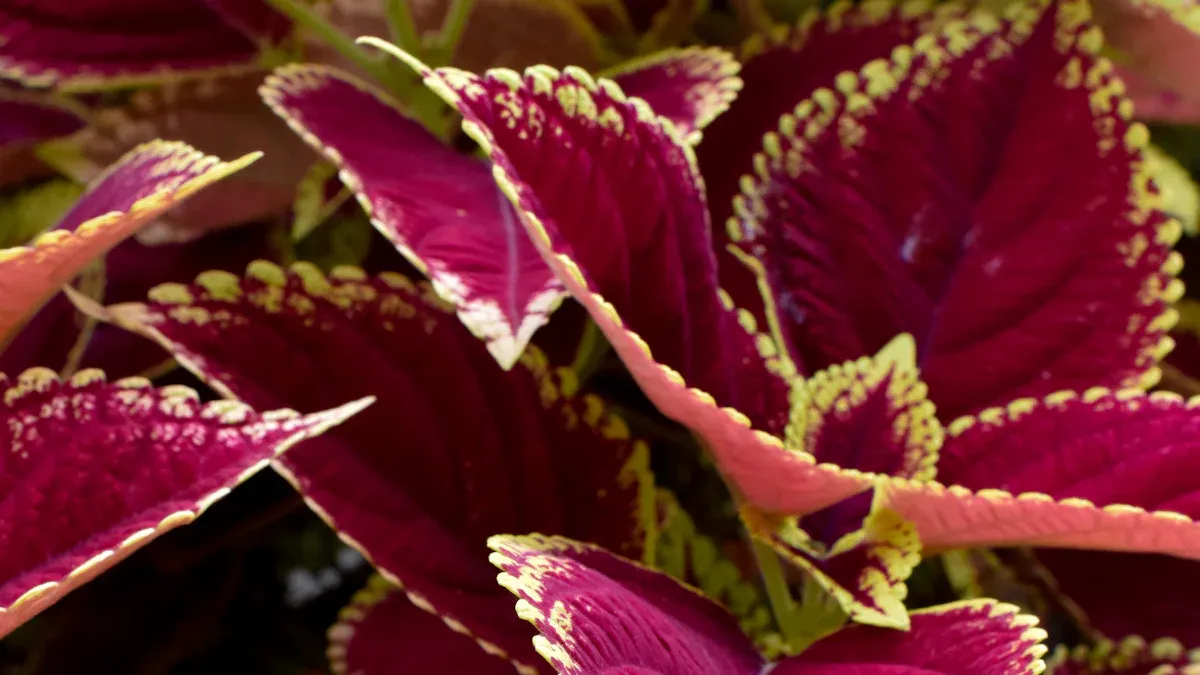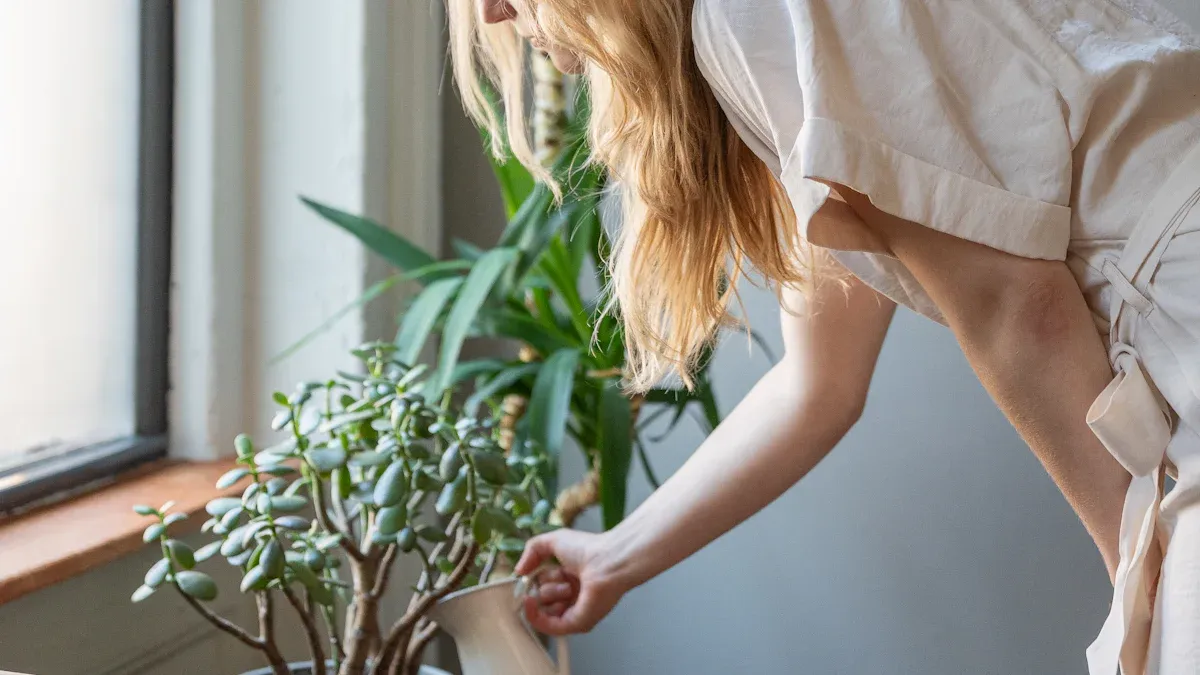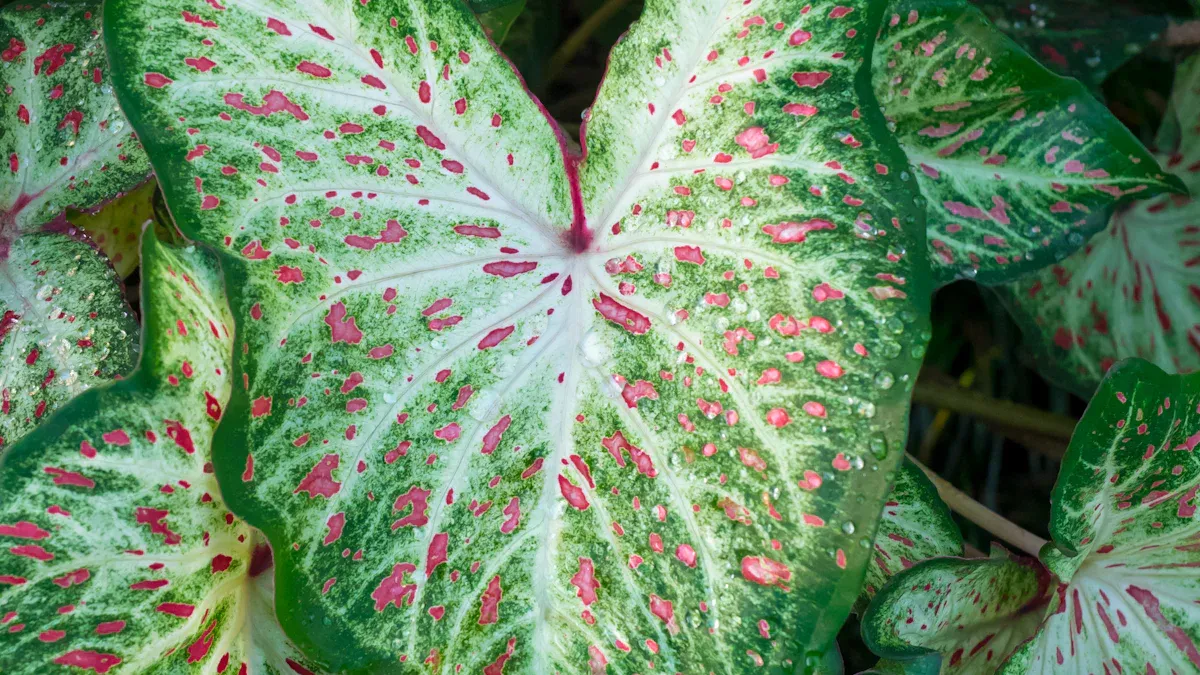
The Iron Cross Plant, scientifically known as Begonia Masoniana, hails from the tropical regions of Southeast Asia. Its distinctive foliage and low maintenance requirements make it a favored option among houseplant enthusiasts. To ensure healthy growth, it is essential to care for the Iron Cross Plant properly. Pay attention to factors such as light, watering, soil, temperature, humidity, and pest management for optimal results.
Scientific Name | Origin |
|---|---|
Begonia Masoniana | Native to tropical and subtropical regions of Southeast Asia, particularly southern China and northern Vietnam. |
Key Takeaways
Provide bright, indirect light for your Iron Cross Plant. This helps maintain vibrant foliage and healthy growth.
Water your plant every 5 to 7 days during the growing season. Check the top 1 to 2 inches of soil to ensure it feels dry before watering.
Use a well-draining soil mix to prevent root rot. Combine potting soil with perlite or pumice for optimal aeration.
Light Needs

Bright Indirect Light
To care for your Iron Cross Plant effectively, you must provide it with bright, indirect light. This plant thrives in medium light conditions, requiring a long light duration of 14 to 18 hours daily for optimal growth. In its natural habitat, the Iron Cross Plant enjoys dappled sunlight filtering through the canopy of trees. You can replicate this environment by placing your plant near a window with sheer curtains or in a well-lit room away from direct sunlight.
Tip: Rotate your plant every few weeks to ensure all sides receive equal light exposure. This practice helps maintain a balanced growth pattern.
Signs of Too Much Sunlight
While the Iron Cross Plant loves light, too much direct sunlight can harm it. If you notice leaf damage, such as browning edges or faded colors, your plant may be receiving too much sun. The intense afternoon sun can particularly cause stress, leading to a loss of its distinctive dark cross pattern on the leaves.
Insufficient light can also lead to problems. When your plant does not receive enough light, it may become leggy, growing taller with less foliage. The leaves may fade in color, indicating poor health. To keep your Iron Cross Plant vibrant and healthy, monitor its light exposure closely.
Visual Indicators of Healthy Foliage:
Healthy leaves are a vibrant green.
Yellowing leaves indicate stress or nutrient deficiencies.
Soft leaves may suggest overwatering.
Crispy leaves often signal underwatering or excessive heat.
By understanding the light needs of your Iron Cross Plant, you can create an environment that promotes healthy growth and stunning foliage.
Watering

Frequency and Amount
Watering your Iron Cross Plant correctly is vital for its health. During the active growing season, which typically spans from spring to early fall, you should water your plant every 5 to 7 days. Before watering again, check the top 1 to 2 inches of soil. If it feels dry, it’s time to water. Aim to keep the soil evenly moist, but avoid overwatering. Overwatering can lead to root rot, a common issue that can harm your plant.
Tip: Always use room temperature water. Cold water can shock the roots and hinder growth.
Dormancy Watering Tips
In winter, your Iron Cross Plant enters a dormant phase. During this time, you should reduce watering frequency. Watering every 10 to 14 days is usually sufficient. The plant requires less moisture as it conserves energy. Always check the soil before watering. If it remains damp, hold off on watering until it dries out.
To help you identify the signs of overwatering and underwatering, refer to the table below:
Condition | Signs |
|---|---|
Underwatering | Drooping or crispy leaves |
Overwatering | Yellowing leaves, mushy base |
By following these watering guidelines, you can effectively care for your Iron Cross Plant and promote healthy growth throughout the year.
Soil Preferences
Best Soil Mix
To care for your Iron Cross Plant effectively, you need to choose the right soil mix. A well-draining soil is crucial for healthy growth. You can create an ideal mix by combining the following components:
Potting soil: Use a high-quality potting mix as the base.
Perlite or pumice: Add 20-30% of perlite or pumice to improve aeration and drainage.
Coconut coir or peat moss: Incorporate a small amount to retain moisture without becoming soggy.
This combination allows the soil to hold enough moisture while preventing water from pooling around the roots.
Drainage Importance
Good drainage is essential for your Iron Cross Plant. Poor drainage can lead to serious issues, such as root rot. Here are some key points to remember:
Overwatering should be avoided, as soggy soil can lead to root rot, a common issue with begonias.
If your plant’s pot doesn’t have drainage holes or if the holes are blocked, water can accumulate at the bottom of the pot and drown the roots.
To prevent these problems, always use pots with drainage holes. This simple step can save your plant from potential harm. By ensuring proper soil and drainage, you can help your Iron Cross Plant thrive and showcase its beautiful foliage.
Temperature and Humidity
Optimal Temperature Range
The Iron Cross Plant thrives in a warm environment. Aim to keep the temperature between 65°F and 75°F (18°C to 24°C). This range mimics its natural tropical habitat. Avoid exposing your plant to temperatures below 50°F (10°C). Cold drafts can stress the plant and hinder its growth.
Tip: If you notice your plant’s leaves curling or dropping, check the temperature. It may be too cold for your Iron Cross Plant.
Humidity Needs
Humidity plays a crucial role in the health of your Iron Cross Plant. This plant prefers medium humidity levels. Dry air can lead to leaf damage and poor growth. To maintain the right humidity, consider the following tips:
Misting: Lightly mist the leaves regularly to increase moisture.
Humidifier: Use a humidifier in the room to create a more humid environment.
Grouping: Place your Iron Cross Plant near other plants to create a microclimate with higher humidity.
By ensuring adequate humidity, you can help your Iron Cross Plant flourish. Remember, maintaining the right temperature and humidity levels is essential for healthy growth.
Fertilization Tips
When to Fertilize
You should fertilize your Iron Cross Plant during its active growing season, which typically runs from spring to early fall. Frequent applications of small amounts of nitrogen-containing fertilizer will support healthy growth. Aim to fertilize every two to three weeks. This schedule helps your plant receive the nutrients it needs without overwhelming it. For young plants, consider using a complete fertilizer every six to eight weeks.
Tip: Monitor your plant’s response to fertilization. If you notice any signs of stress, adjust the frequency or amount of fertilizer.
Recommended Fertilizers
For optimal growth, use a general-purpose fertilizer with a balanced NPK ratio. Suitable formulations include 2-8-8, 4-8-8, 6-6-6-3, or 8-3-9-5. Regular feeding during the growing season ensures your Iron Cross Plant receives the necessary nutrients for both growth and flowering. You can also apply micronutrients two to four times per year to enhance overall health.
Note: Reduce fertilization during winter. Your plant enters a dormant phase and requires less nutrition. Fertilizing during this time can lead to nutrient buildup and harm your plant.
By following these fertilization tips, you can help your Iron Cross Plant thrive and enjoy its beautiful foliage.
Pest Management
Common Pests
Your Iron Cross Plant may face challenges from common pests. Two of the most frequent culprits are:
Aphids: These tiny insects cause curled leaves and leave a sticky residue on the plant.
Spider Mites: These pests create fine webbing and cause stippled leaf surfaces.
If you notice yellowing leaves or reduced vigor in your plant, these pests might be the cause. Regular monitoring can help you catch infestations early.
Prevention Strategies
To keep your Iron Cross Plant healthy, implement these prevention strategies:
Regular Pruning: Trim your plant to maintain its compact shape and promote healthy growth.
Soil Monitoring: Ensure the soil remains well-draining and not overly moist. This practice is crucial for maintaining plant health.
If you encounter pests, consider the following treatment options:
Pest | Treatment Options |
|---|---|
Aphids | – Spray leaves with cold water several times a day. |
– Apply insecticidal soaps, horticultural oils, or neem oil to the leaves of affected plants. | |
– Use a mixture of 1 quart water to 1 tsp dish soap sprayed on leaves for two weeks. | |
– Use pesticides for severe infestations. | |
Spider Mites | – Isolate affected plants to prevent spreading. |
– Spray leaves and stems with water several times a day. | |
– Introduce neutral predators like ladybugs. | |
– Apply neem oil or insecticidal oil to the leaves. | |
– Use insecticidal soaps that list potassium as the main ingredient. |
By following these pest management tips, you can protect your Iron Cross Plant and ensure it thrives in your home.
Common Issues and Solutions
Leaf Discoloration
Leaf discoloration is a common issue for Iron Cross Plant owners. You may notice yellowing or browning leaves, which can indicate several problems. One major cause is low humidity. To address this, consider the following solutions:
Misting the plant a couple of times a week to increase humidity.
Using a pebble tray to boost humidity through evaporation.
Washing the plant in the shower to refresh it and remove dust.
Investing in a humidifier for consistent humidity levels.
Ensuring the plant is not exposed to direct sunlight to prevent leaf burn.
By implementing these strategies, you can help restore your plant’s vibrant foliage.
Stunted Growth
Stunted growth can frustrate any plant owner. Several factors contribute to this issue. Poorly drained soils often lead to stunted growth. To tackle this, evaluate your planting site and check soil moisture levels after watering. If the soil remains waterlogged, consider reworking or raising the planting bed. Adding compost or peat moss can improve drainage significantly.
Another common cause of stunted growth is iron deficiency. This micronutrient is crucial for your plant’s health. Soil pH affects iron availability, with lower pH levels improving accessibility. Regularly test your soil and adjust the pH if necessary. By addressing these issues, you can encourage healthy growth in your Iron Cross Plant.
Caring for your Iron Cross Plant involves providing the right light, water, soil, temperature, and humidity. Implement these essential tips to ensure healthy growth. Enjoy the beauty of your plant as it thrives in your home. Remember, proper care leads to vibrant foliage and a happy plant!
FAQ
How often should I repot my Iron Cross Plant?
Repot your Iron Cross Plant every 1 to 2 years or when it outgrows its pot.
Can I propagate my Iron Cross Plant?
Yes, you can propagate it through leaf cuttings or division during the growing season.
What should I do if my plant has pests?
Isolate the plant and treat it with insecticidal soap or neem oil to eliminate pests effectively.


